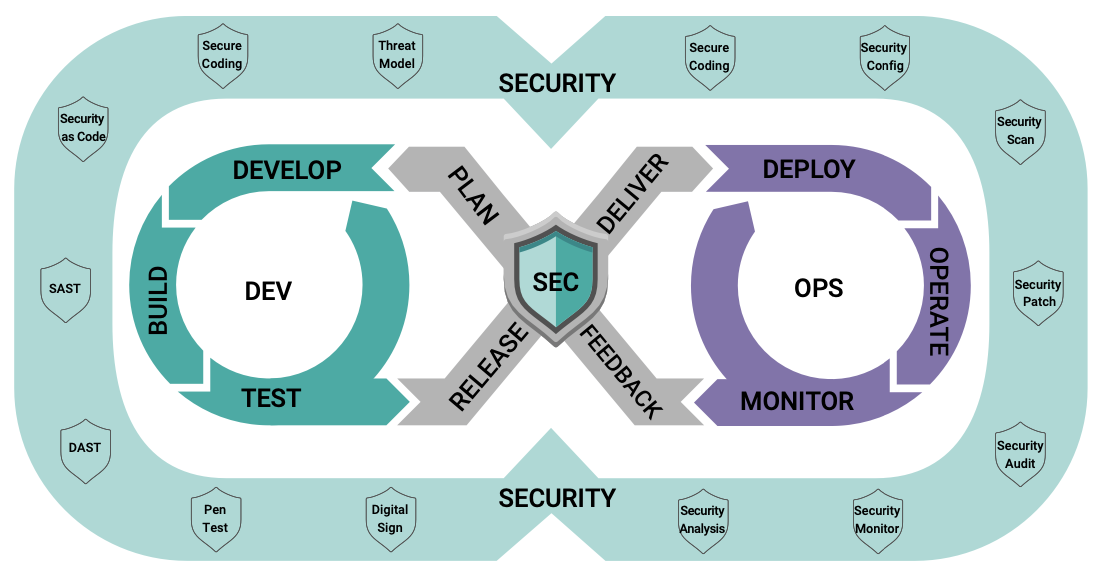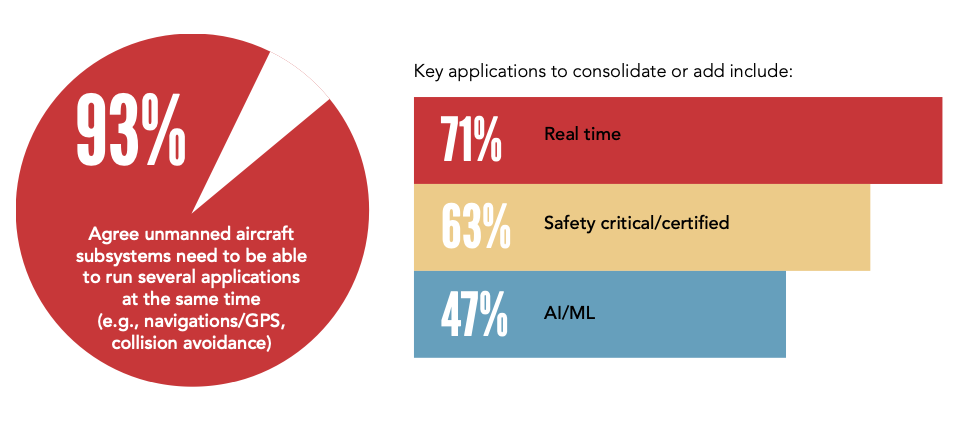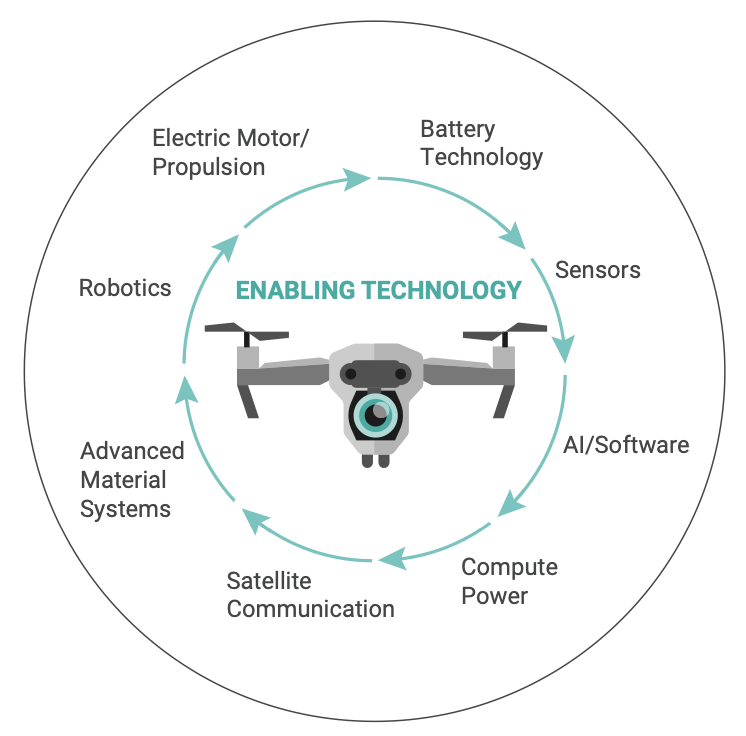Meeting the Challenges of Next-Generation Advanced/ Urban Air Mobility Systems
Delivering Reliability, Safety, and Security
EXECUTIVE SUMMARY
From the Wright brothers’ first flight off the sands of Kitty Hawk to supersonic jets and hypersonic vehicles, the aerospace industry has steadily advanced from one innovative technology to another. Over the years, experts have matured and leveraged new technologies and techniques to enable the development of air vehicles that would meet new flying challenges. Today, one of the most exciting opportunities is the application of electric vertical takeoff and landing (eVTOL) vehicles and other innovative propulsion and flight technologies to realize advanced/urban air mobility (AAM/UAM) in support of dual-use commercial and military missions.
To bring advanced eVTOL technology and innovation to the market faster and to meet AAM challenges, there must a collaboration between aerospace companies, software innovators, and government regulation entities. Airspace management frameworks must evolve intelligently for the safe operation of eVTOL aircraft to support the commercial eVTOL industry and bring its players together to enable safety, security standards, and more. Wind River®, a software solutions leader in the aerospace and defense market, is committed to helping bring eVTOL to reality with its full portfolio of software products that deliver proven reliability, safety, and security to flight technology. In this white paper, Wind River will focus on meeting the challenges of the technology, solutions, and innovations that are required to make the next generation of AAM/UAM systems a reality.
TECHNOLOGY CHALLENGES FACING ELECTRIC VERTICAL TAKEOFF AND LANDING
To make eVTOL a viable reality, the industry will have to overcome four major technical challenges.
Design
As eVTOL companies put their scientists and engineers to work, they need to focus on the aspects of the design and the use of technology that will enable successful vertical takeoff and landing and provide the greatest range of flight, making size, weight, and power (SWaP) considerations more important than ever. Currently, while a larger battery will provide electric power for flight, its weight can also shorten flight time and range. To get a design jump on this power and range challenge, some companies are looking at combining electric power with conventional engines, resulting in hybrid VTOLs, or hVTOLs. Overall, the successful design of eVTOLs needs to incorporate software solutions from the very start to address the range/endurance and SWaP challenges.
Development
An intelligent compute system is a major component of modern aviation technology. Its development relies on DevOps, which uses agile practices to support constant integration and delivery of new or updated code. In its latest evolution, DevSecOps further incorporates security into the intelligent software platform from the outset. eVTOL software developers need to plan for a system development lifecycle (SDLC) that incorporates:
- Investigation
- Analysis
- Design
- Build
- Testing
- Implementation
- Maintenance, support, and upgrades

DevSecOps tools help secure the development workflow, ensuring that systems are free of vulnerabilities and that the eVTOL is secure during operation. To incorporate agile software development into the production of eVTOL systems, developers must build in software tools and technologies such as virtualization, containerization, orchestration, automation, commercial off-the-shelf (COTS) software, configuration management tools, and more. A constant flow of data via a digital feedback loop is imperative for the continuous updating, debugging, and improvement of the applications, systems, and operations of an eVTOL’s avionics.
Security
eVTOLs must have security planned and built into their systems from the start to prevent potential cybersecurity threats. Following a DevSecOps-compliant process, manufacturers can create a strong, secure system with built-in security features that can be easily and securely updated as new cybersecurity threats emerge. eVTOL system developers should take advantage of the real-time operating systems and open system software that have strong security features and functions. Additionally, the use of both virtualization and containerization technologies should incorporate strong security functions to protect the operation of the systems. To ensure cybersecure development and systems, cybersecurity testing should be conducted via DevSecOps processes throughout the product lifecycle. Simulation testing can allow developers to create the virtual equivalent of the eVTOL system and conduct security penetration tests (pen tests) to determine the vulnerability of the systems and their effects, all without incurring actual damage or needing to purchase expensive test systems. Simulation software can create a digital twin of the eVTOL to conduct ongoing assessments of the system. eVTOLs must meet stringent security standards based on NIST 800-53, classified data at rest, multilevel security, and anti-tamper requirements.
AN INTELLIGENT SYSTEM PLATFORM FOR EVTOL
The heart of a quality eVTOL is an intelligent system platform based on software that operates efficiently, cost-effectively, safely, and securely. Evolving artificial intelligence (AI) and machine learning (ML) technology will be critical to this intelligent system. The eVTOL system will need an RTOS that enables the flying vehicle’s rapid and deterministic operation and function. There will also be systems within the eVTOL that can run on open source software such as Linux.
Nevertheless, whether the system’s foundation is an RTOS or a general-purpose operating system, it must deliver reliability, safety, and security to vehicle operations. Furthermore, cloud computing is now a part of all areas of business, manufacturing, energy, transportation systems, and more. Because it combines AI, ML, and 5G communication, cloud computing will play a major role in eVTOL flight data and control systems.

An intelligent system platform will be a part of each eVTOL vehicle’s functional components. Its software applications will provide the AI and ML intelligence that are key to the functional systems: They will manage, direct, and operate such functional areas as airspace deconfliction, aided navigation, flight safety, and terminal area operations. Beyond traditional avionics, the intelligent system platform will also encompass vehicle, mission, and communication management systems. Additionally, new cloud-computing technology will provide expanded systems development capabilities.
HOW WIND RIVER MEETS THE CHALLENGES
The Wind River software portfolio allows the eVTOL developer to design a software-defined architecture for vehicle operation. With a cloud-computing intelligent platform, virtualization technology, and containerization capabilities, a flexible and expandable intelligent platform can be built. Ultimately, Wind River software can offer the value of certifications that will help eVTOL builders meet security and safety requirements while also saving time, resources, and cost. The Wind River software portfolio offers offers future proofing and open architectures that allow seamless migration from prototyping to production and ultimately lifecycle maintenance, support, and upgrades.
VxWorks: Market-Leading Real-Time Operating System
The powerful capabilities of VxWorks, the industry-proven RTOS from Wind River, support modern development methods for building solutions that are secure, safe, reliable, and certifiable. VxWorks accelerates data-processing tasks in aviation system environments and ensures responsive operations in mission-critical deployments. VxWorks supports 32- and 64-bit and multi-core processors, including Intel®, Arm®, Power Architecture®, and RISC-V. VxWorks helps lower procurement and certification costs while meeting stringent industry standards such as DO-178C, ED-12C, ARINC 653, POSIX®, and FACE™ by using COTS standards conformance and safety certification evidence. VxWorks has an extensive history of safety certification including DO-178C DAL A, ISO 26262 ASIL D, IEC 62304, and IEC 61508 SIL 3. Additionally, VxWorks supports C11/C++17 programming language standards, Rust, LLVM, Python programming language, and Boost C++ libraries, helping application developers create efficient, portable applications. VxWorks is the only RTOS supporting IT-like application deployment with OCI container support.
Wind River Studio: Secure Collaboration at the Intelligent Edge
This cloud-native platform is a secure foundation for the development, deployment, operations, and servicing of vital intelligent edge systems. Optimized for DevSecOps, Studio enables application teams to employ continuous integration (CI) and continuous delivery (CD) workflows, drawing on agile development practices. These capabilities are paramount to the future of intelligent machines and responsive cloud-based infrastructures. eVTOL systems development teams can use the capabilities of Studio to accelerate their software development work and promote collaboration among geographically dispersed teams, while ensuring safety and security.

Wind River Professional Services: From Architecture Studies Through Development and Operations
Professional Services provides access to comprehensive knowledge and expertise to help Wind River customers unlock the full potential of Wind River products, dramatically reducing the risks and time associated with creating and integrating new technologies. Professional Services offers insights, expertise, and resources built from nearly four decades of leadership in the embedded software industry. The Professional Services team works with customer development teams so they can focus on their core competencies and deliver market-leading devices, systems, and networks.
Professional Services helps design teams bring safe, secure, reliable, and compliant mission-critical products to market. Additionally, the team offers its Information Assurance (IA) Foundation to provide the APIs for the security devices within the QorIQ PPC processor family.
Wind River Titanium Security Suite
Star Lab, the Wind River Technology Protection and Cybersecurity Group, protects mission-critical embedded systems against cybersecurity and anti-tamper vulnerabilities in contested environments using a hardened Linux suite of security products. Wind River Titanium Security Suite (developed by Star Lab) specializes in tactical virtualization, operating system hardening, secure boot technology, and data-at-rest encryption with significant expertise and a long pedigree of success in developing tailored security solutions for military systems. Star Lab personnel have a demonstrated track record of operational excellence with no failures in the field and a 100% success rate in achieving certification, verification, and validation testing requirements. All employees are U.S. citizens with clearances, giving customers confidence and trust in the company and its staff.
CONCLUSION
Over the course of the next two to three years, the AAM/UAM industry will undergo a significant transformation as it matures concepts into prototypes, sub-scale air vehicles into full-scale models, and manually operated systems into highly automated — and in some cases autonomous — ones. Wind River, with its established and growing portfolio of software capabilities, looks forward to partnering with industry, government, systems, and academia to provide an intelligent systems platform that enables eVTOL vehicles to reliably, safely, and securely take flight.
As innovative development for electric vertical takeoff and landing vehicles continues, eVTOL designers will face a variety of challenges in design, development, safety, and security. To learn more about the Wind River portfolio, visit www.windriver.com or contact salesinquiry@windriver.com.